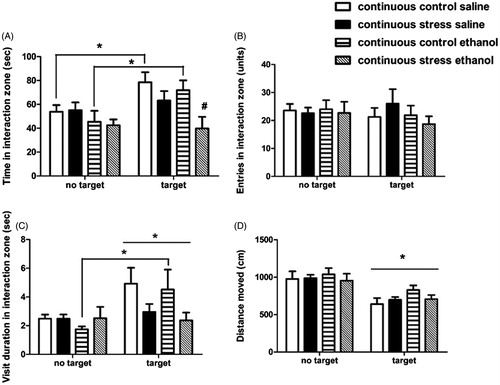Figures & data
Figure 1. Timelines for experiments 1 and 2. D = day. D1 to D10: days when mice were exposed to social defeat (episodic or continuous); D16 and D17: habituation to i.p. injection handling; D18: control and stressed mice were tested for social investigation.

Figure 2. Behavioral assessment during the social investigation test after episodic defeat stress. Mice were exposed to episodic defeat stress for 10 days, and treated with 1.0 g/kg ethanol or saline (i.p.) prior to the social investigation test (n = 7–11/group), 8 days post-stress. Behaviors were recorded in the absence (“no target”) or presence (“target”) of a social target inside a wire interaction cage. Mice received ethanol/saline administration immediately after the “no target” test and 5 min prior to the “target” test, thus mice were not under ethanol effects during the “no target” test. The duration of the test was 150 s for each condition. Behavioral parameters were analyzed by three-way ANOVAs with repeated measures (factors “group”, “treatment”, and “test” as the repeated measure). (A) Time spent (s) in the 5-cm interaction zone around the interaction cage; (B) Number of entries into the interaction zone; (C) Average duration of visiting bouts to the interaction zone (s/entry); (D) Distance moved (cm). Results shown as means ± SEM. *p < .05, difference between tests (target vs. no target); #p < .05, relative to episodic control saline group, during the target test.

Figure 3. Behavioral assessment during the social investigation test after continuous defeat stress. Mice were exposed to continuous defeat stress for 10 days, and treated with 1.0 g/kg ethanol or saline (i.p.) prior to the social investigation test (n = 8–14/group), 8 days post-stress. Behaviors were recorded in the absence (“no target”) or presence (“target”) of a social target inside a wire interaction cage. Mice received ethanol/saline administration right after the “no target” test and 5 min prior to the “target” test, thus mice were not under ethanol effects during the “no target” test”. The duration of the test was 150 s for each condition. Behavioral parameters were analyzed with three-way ANOVAs with repeated measures (factors “group”, “treatment”, and “test” as the repeated measure). (A) Time spent (s) in the 5-cm interaction zone around the interaction cage; (B) Number of entries into the interaction zone; (C) Average duration of visiting bouts to the interaction zone (s/entry); (D) Distance moved (cm). Results shown as means ± SEM. *p < .05, difference between tests (target vs. no target); #p < .05, relative to continuous control saline group, during the target test.

